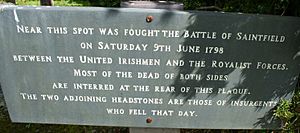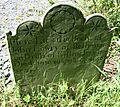Battle of Saintfield facts for kids
Quick facts for kids Battle of Saintfield |
|||||||
|---|---|---|---|---|---|---|---|
| Part of the Irish Rebellion | |||||||
 Plaque commemorating the battle. |
|||||||
|
|||||||
| Belligerents | |||||||
| Commanders and leaders | |||||||
| Richard Frazer McKinstry ☠ |
Colonel Hon. Granville Anson Chetwynd-Stapylton | ||||||
| Strength | |||||||
| 1,000 at least | 350, two six-pounder guns | ||||||
| Casualties and losses | |||||||
| 30–40 killed | 58 killed ~10 captured |
||||||
The Battle of Saintfield was an important fight during the Irish Rebellion of 1798. It happened in County Down, which is in Northern Ireland today. This battle, on June 9, 1798, was the first big clash of the rebellion in that area.
Contents
What Led to the Battle?
A group of rebels, more than a thousand strong, gathered around a big house. This house belonged to the McKee family. The McKees were known as Loyalists, meaning they supported the British government. They were not popular in the area.
About a year before, the McKees had told the authorities about a Presbyterian minister named Thomas Ledlie Birch. He was a United Irishman, a group that wanted Ireland to be independent. Because of the McKees, Birch and some of his church members were arrested.
The McKee family knew they were disliked. So, they had many weapons to protect themselves. When the rebels surrounded their house, shots were fired from inside. This kept the rebels back for a short time. Then, a fiddler named Orr managed to get around the back of the house. He used a ladder to set the roof on fire. The house was destroyed, and all eight family members inside died.
News of this quickly reached the British forces nearby. A group of 300 soldiers, led by Colonel Granville Staplyton, marched to the area. This force included cavalry from Newtownards and 270 York Fencibles (soldiers who served only in Britain or Ireland). They also had two small cannons.
The Battle Begins
The Irish rebels had expected the British to come. They waited in an ambush for the soldiers. Colonel Staplyton saw the road ahead twisted into some woods. He sent two scouts to check if it was safe. The scouts did not look carefully enough. They came back and said the road was clear.
The British soldiers, called "redcoats" because of their uniforms, marched into the wooded area. A thick hedge ran along one side of the road. On the other side, the ground went uphill into more woods. This gave the Irish rebels good places to hide.
The Irish rebels mostly fought with pikes. A pike is a long pole with a sharp metal tip. The land allowed them to quickly rush the soldiers on the road below.
Fierce Fighting
A very intense hand-to-hand fight followed. The British soldiers were quickly overwhelmed. One soldier, who had fought in wars in Europe, survived the attack. He later said he had never seen such fierce fighting. He explained that "Every man had to fight his way... against the charged pike and other weapons." These were weapons he was not used to.
More than fifty British soldiers were killed by pikes. Colonel Staplyton finally managed to give orders to his soldiers. He then used his cannons against the large group of rebels. The cannons fired canister and grapeshot, which are types of ammunition that spread out like a shotgun blast. This caused many casualties among the rebels.
This gave Staplyton's force a chance to escape to safety. The next day, the York Fencible Regiment of Foot, which Staplyton had left in Newtownards, fought off a rebel attack. This attack was led by David Bailie Warden. After that, the Fencibles left Newtownards and went through Comber to rejoin their commander in Belfast.
What Happened Next?
The Battle of Saintfield was seen as a victory for the United Irish rebels. Many years later, in the 1950s, two skeletons, a sword, and a bayonet were found in the area. These likely belonged to the York Fencibles.
However, the rebellion in County Down did not last long. The day after the battle was called "Pike Sunday." On this day, Minister Birch spoke to the entire rebel army gathered at Creevy Rocks. He told them: "Men of Down, we are gathered here today ... to pray and fight for the liberty of this Kingdom of Ireland. We have grasped the pike and musket to fight for the right against might, to drive the bloodhounds of King George the German king beyond the seas. This is Ireland, we are Irish and shall be free."
The rebel army from north Down then marched south. They joined a larger rebel group led by Henry Munro. But this larger group was defeated on June 12 at the Battle of Ballynahinch.
Many of the soldiers and rebels who died at Saintfield were buried together. They were placed in a mass grave at the nearby Presbyterian church. There is a plaque marking where these graves are.
In May 2010, a memorial park was completed and opened. The area has been cleaned up and made into a nice park. Several new plaques and information boards have been put up. The graves have also been fixed up, and the headstones have been put back in place.
Images for kids
- 1798 United Irishmen graves



